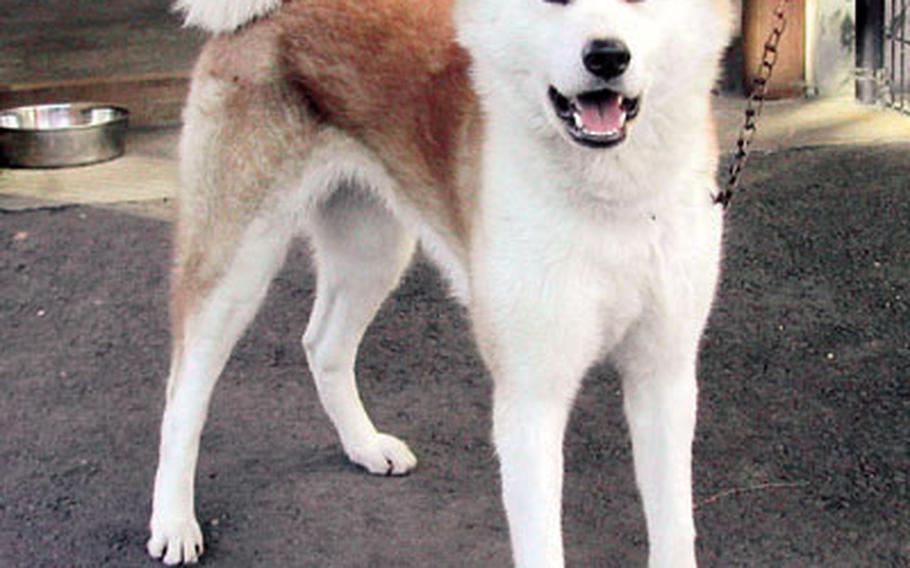
A year-old Akita dog outside the museum. (Hiroshi Chida / S&S)
TOKYO — Deep in the snow of Odate in the northern Akita Prefecture is the home of the Akita dog — which is known in Japan, as well as throughout the world.
The Akita is loved for its stately appearance and its nature — loyal, obedient and brave. It rarely barks. It is also Japan’s largest dog, both in size and weight. The average height of an adult dog is about 26 inches and weighs almost 90 pounds.
Akitas are said to have come to Japan before Japan and the European continent were separated by the Sea of Japan. Some of the Akita’s descendants worked as hunting dogs to assist bear hunters.
During the Meiji era of 1868-1912, dogfights became popular in Japan. Tosa fighting dogs were introduced to Odate and cross-bred with the Akita. The people of Odate deplored the decrease of a pure Akita breed; then-Odate mayor Shigeie Izumi founded the Akita Dog Preservation Society in 1917 to preserve the full blood Akita.
Since then, the people of Odate and the society members have become devoted to preserving the pure Akita. In 1931, the Akita breed was designated a Japanese Natural Treasure. In 1967, commemorating the 50th anniversary of the society’s foundation, the Akita Dog Preservation Society built the Akita Dog Museum which houses all sorts of information, documents and photos.
The Akita did not always have the popularity it holds today. In 1932, when the dog was only known for being local to Odate, an incident occurred that brought the dog its current recognition.
The Asahi Shimbun newspaper reported in 1932 about a faithful Akita dog owned by Dr. Eisaburo Ueno, a Tokyo University professor. The dog was named Hachi.
Every morning, the professor would walk to Shibuya station on his way to work — accompanied by his loyal dog. When the professor returned to the station every day at 3 p.m., the dog was always waiting for him.
However, on May 21, 1925, Ueno died of a stroke while at the university. Hachi went to Shibuya as always to meet his master, but 3 o’clock came and the professor didn’t arrive. So Hachi waited … and waited …
When Ueno passed away, Hachi was only a year and a half old. For the next ten years, Hachi continued to go to Shibuya station every evening to wait for his master.
People began to notice the loyal dog’s trips made in vain to meet his master.
The Shibuya stationmaster and others began feeding Hachi and giving him shelter, and he developed the nickname of Chuken Hachiko — “Faithful Dog Hachiko.”
When the newspaper printed the story, contributions poured in from all over the country. The famous sculptor Ando Teru was hired in 1934 to create a sculpture of the dog; a similar statue was built at Odate Station in 1935.
When Hachiko died in 1935 it bannered the front pages of Japanese newspapers.
During the World War II period, the Odate and Shibuya statues were taken by the government to be made into weapons. A new Hachiko statue was built in Shibuya in 1948 and Odate in 1987. Today, Shibuya’s Hachiko is a landmark where people — especially young students — meet.
Hiroshi Matsukawa of the Akita Dog Preservation Society said the first Akita to go to America was for Helen Keller. The famous U.S. author and educator — who was blind and deaf — visited Japan in 1937 and desired an Akita dog as her pet; one was donated to her.
Matsukawa said there are about 30,000 registered Akitas in Japan. There are about five times that number in the United States, he said, because Americans who came to Misawa as occupation forces after World War II came to know the Akita and they liked them so much they took them back to the United States.
If You Go ...
Directions: JR Ou Line or JR Hanawa Line to Odate Station. If you drive from Misawa, take The 2nd Michinoku Toll Road from Misawa which is connected to Tohoku Kosoku (highway) and go to Towada Interchange. Odate is about 40 minutes from Towada interchange.
Museum: 9 a.m. to 4 p.m.; closed Saturday afternoon, Sunday and holidays; 100 yen; 0186-42-2502